Surrounded by mountains on all sides, a collection of pastures, fields, mills, barns and an assortment of other old buildings and cabins, Cades Cove is representative of what life in America used to be. The pioneer way of life.
The national park system has undertaken the task of preserving this pioneer way of life in Cades Cove by transforming it into a historic exhibit through the rehabilitation and preservation of log cabins, barns, mills, churches and other structures. Cattle, hay and grain continue to be raised today by farmers and the park service.
Cohabitating in the Cove is a plethora of wildlife that include deer, bear, wild boar, turkey and coytoe. I would say that the wildlife for many of the Cove's visitors is the main attraction. Without fail a drive around the Loop Road will offer numerous opportunities to view deer grazing, young bucks testing their skill and strength on each other, turkey scratching the ground looking for a tasty morsel. In the spring and fall, it is not at all uncommon to come up on a bear or as in my case have the bear come up on me while I was photographing one of the cabins. (The below bear photo is the result of that delightful surprise) Early mornings in the Cove often offer a glimpse of a coyote hunting in the open fields.
Wild Turkey scratching for food
An Alert Doe
A Typical View in the Cove
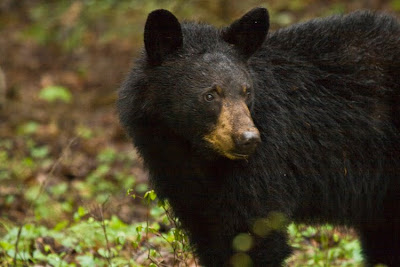
A adolescent bear out looking for a meal
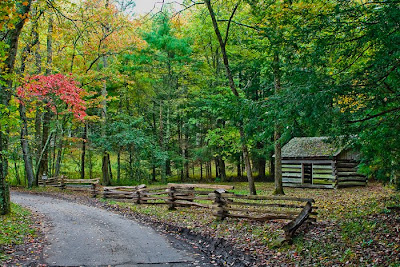
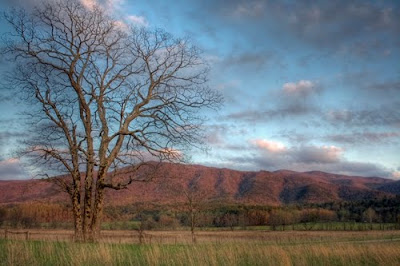
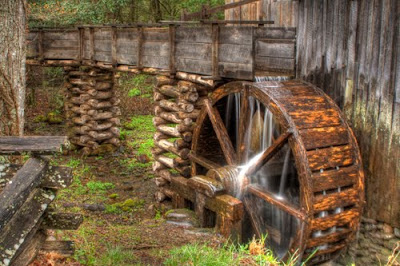
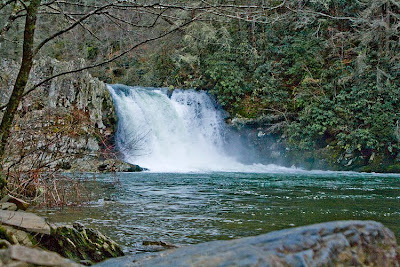
Earlier I briefly alluded to the pioneer way of life. Any discussion of the Cove would be remiss if it didn't include the settler's of the area. The first white man to permanently settle in the Cove was John Oliver who established residence in 1818.
The John Oliver Place
was occupied by the family until the establishment of the park in 1934. I have seen a photograph of this cabin with an old model A or T Ford (I'm not sure which it was an old Ford of some sort) and laundry hanging out on a clothes line to dry.
However, the first Cades Cove related land grant was given to Hugh Dunlap in 1794 for 5,000 acres. Another grant given in 1796 was to William Crowson. These grants were actually given illegally; for at that time the land belonged to the Cherokee Indians and was not open to white settlement until the treaty of 1819. Settlement began in earnest and in 1821 William Tipton purchased 640 acres from William Crowson.

One of the out buildings of the Tipton Place
William Tipton eventually ended up owning over 3,000 acres both in the Cove and on the surrounding mountain sides.
Dan Lawson Place

As the settlers began pouring into the region, the land was deforested for pastures, orchards and crops were planted. The settlers were surrounded by mountains and Hyatt Lane was the only road out. Hyatt Lane went across the cove to then Cades Cove Rd., now Rich Mountain Rd. To travel to Maryville from Cades Cove was a three day trip on horseback.
Hyatt Lane
Another Road that cuts across the cove is Sparks Lane.
Sparks Lane
The soil in the cove was fertile and farming was prosperous; corn being the main crop. However, it was not practical for the farmers to try to carry the corn over the poor mountain road into Maryville to market. Corn was selling for 6.25 cents a bushel. The farmers instead fed a majority of the corn to livestock which could be driven to the markets.
Corn was also a family staple, often ground in tub mills by individual families until such time when a community became large enough to support a water wheel powered mill. The Cades Cove community was one such community that in fact by 1870 was large enough to support more than one mill. John P. Cable's mill was a dual mill both wood and corn. John P. Cable was also a farmer and it is told that he had a large bell mounted on a pole in front of the mill for customers to ring to bring him in from the fields. The Cable mill is one of the buildings the park service has restored but much of the mill is still original.

Waterwheel of Cable's Mill
There is one other aspect of the cove to cover. Prior to the settlement of the white man the Cherokee Indians lived here. Cades Cove, Abrams Creek and Abrams falls all obtained their name from a well known Cherokee Chief, "Old Abram" who live in the nearby village at Chilhowee. According to local lore Old Abram's wife was named Kate which became Cades or Kate's Cove, in her honor.

Abrams Falls
That my friends is a brief (too brief to be of any real informational value) history of the cove and my humble attempt to capture and share some of it's beauty. In two short weeks the cove will be closing so that the park service may attend to the maintenance of some of the buildings and rebuild the well travelled Loop Road. Good Bye old friend, until your reawakening in summer. I'm sure I speak for many when I say we will miss you.
Until next time; Have fun with your photography,
Laura















No comments:
Post a Comment